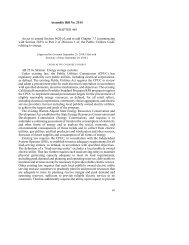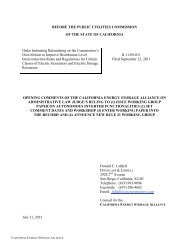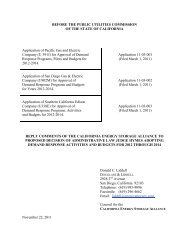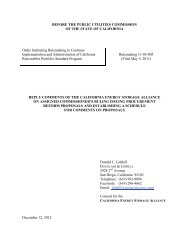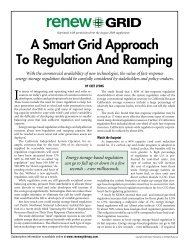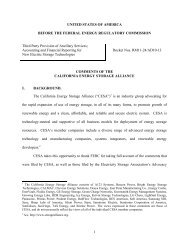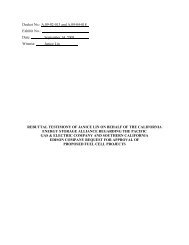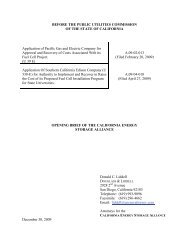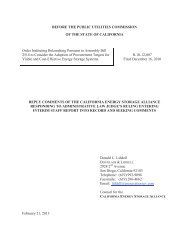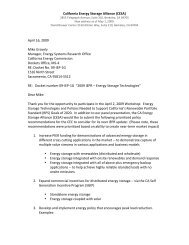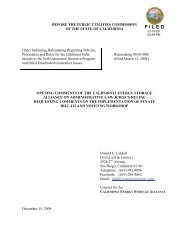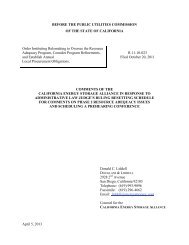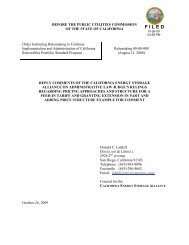CEC 2011 Integrated Energy Policy Report Workshop Comments
CEC 2011 Integrated Energy Policy Report Workshop Comments
CEC 2011 Integrated Energy Policy Report Workshop Comments
You also want an ePaper? Increase the reach of your titles
YUMPU automatically turns print PDFs into web optimized ePapers that Google loves.
December 17, 2010<br />
E‐mail to docket@energy.state.ca.us<br />
Presiding Member: Chairman Karen Douglas<br />
Associate Member: Jeffrey D. Byron<br />
Original copy to<br />
California <strong>Energy</strong> Commission<br />
Docket Office, MS‐4<br />
Re: Docket 11‐IEP‐1<br />
1516 Ninth Street<br />
Sacramento, CA 95814‐5512<br />
Re:<br />
<strong>Comments</strong> of the California <strong>Energy</strong> Storage Alliance on <strong>2011</strong> <strong>Integrated</strong> <strong>Energy</strong> <strong>Policy</strong><br />
<strong>Report</strong> (“IEPR”) Committee Scoping Memo<br />
Docket 11‐IEP‐1<br />
Dear Chairman Douglas and Associate Member Byron:<br />
The California <strong>Energy</strong> Storage Alliance (“CESA”) is pleased to submit these comments that relate<br />
to both the November 16 <strong>Workshop</strong> on <strong>Energy</strong> Storage and Automated Demand Response<br />
Technologies to Support Renewable <strong>Energy</strong> Integration and the November 23 Joint Committee<br />
<strong>Workshop</strong> on Electricity Infrastructure Need Assessment.<br />
CESA appreciates your efforts to explicitly address energy storage and its role in supporting<br />
renewable integration. The <strong>Workshop</strong>s are consistent with the direction provided in the July 12,<br />
2010 scoping memo which noted that “An important subtopic in the <strong>2011</strong> IEPR will be energy<br />
storage as it relates to integrating preferred resources into the electricity system.” Both<br />
<strong>Workshop</strong>s are also timely, given the recent enactment of AB 2514 and the CPUC's rapid<br />
response to begin implementation of this historic new legislation. 1 Further, the ongoing Long<br />
Term Procurement Planning effort at the CPUC will similarly benefit from the <strong>CEC</strong>’s policy<br />
leadership in this area.<br />
Given the <strong>CEC</strong>’s already established leadership with respect to energy storage, as noted above,<br />
CESA was dismayed to see that the November 23 Joint Committee <strong>Workshop</strong> on Electricity<br />
Infrastructure Need Assessment came to a different and perplexing conclusion. In particular, on<br />
pages 31, 35 and A‐5 the document states: "Reference to dispatchable fossil resources does not<br />
negate the possible role that storage technologies might play in satisfying some portion of the<br />
1 Order Instituting Rulemaking was unanimously approved by the CPUC on December 16, 2010.<br />
CESA • 2150 Allston Way, Suite 210, Berkeley, CA 94704 • 510.665.7811 • www.storagealliance.org<br />
A123 Systems • AIC/East Penn • AltairNano • Beacon Power • Chevron <strong>Energy</strong> Solutions<br />
Deeya <strong>Energy</strong> • EnerSys • EnerVault • Debenham <strong>Energy</strong> • Fluidic <strong>Energy</strong> • Ice <strong>Energy</strong><br />
International Battery • Powergetics • Primus Power • Prudent <strong>Energy</strong> • PVT Solar<br />
ReStore <strong>Energy</strong> Systems • Samsung SDI • SEEO • Suntech • SunVerge • SustainX • XtremePower
needs currently carried by dispatchable fossil generation. However, there is no standardized<br />
manner of describing the specific capabilities of ‘storage’ or its degree of control by system<br />
operators. Absent this, ESAD assumes that storage remains a niche or R&D technology with<br />
promise, but not yet able to play a substantive role in displacing dispatchable fossil<br />
generation.“ (Page A‐5).<br />
CESA strongly disagrees with this latter statement. Storage can and will play a significant role in<br />
displacing dispatchable fossil generation. This case has been made by the <strong>CEC</strong> as recently as this<br />
past summer in the report titled “Research Evaluation of Wind Generation, Solar Generation and<br />
Storage Impacts to the California Grid (<strong>CEC</strong>‐500‐2010‐010). Key conclusions of this report<br />
(source pages 15‐16) include:<br />
Large‐scale storage can improve system performance by providing regulation<br />
and imbalance energy for ramping or load following capability.<br />
Increasing regulation amounts, without the use of storage and improved control<br />
algorithms, can improve system performance. However, roughly 2‐to‐10<br />
times the amount of today’s regulation and balancing capacity would be<br />
required to maintain system performance absent other operating protocols,<br />
such as limiting ramp rates and new services that could be developed as<br />
alternatives to address renewable ramping as well as scheduling and forecasting<br />
errors.<br />
Existing battery technologies appear to have the capabilities required to manage<br />
renewable integration, including two‐hour durations and ramping capabilities<br />
of 10 MW/second or greater.<br />
On an incremental basis, storage can be up to two to three times as effective as<br />
adding a combustion turbine to the system for regulation purposes.<br />
The CPUC also supports the near term evaluation and inclusion of energy storage in California’s<br />
electric power system as noted in the new <strong>Energy</strong> Storage OIR:<br />
“Although the Legislature has given the Commission until March 1, 2012 to open<br />
this proceeding, we see the enactment of AB 2514 as an important opportunity<br />
for this Commission to continue its rational implementation of advanced<br />
sustainable energy technologies and the integration of intermittent resources in<br />
our electricity grid.” (Page 1, OIR)<br />
2<br />
CESA • 2150 Allston Way, Suite 210, Berkeley, CA 94704 • 510.665.7811 • www.storagealliance.org<br />
A123 Systems • AIC/East Penn • AltairNano • Beacon Power • Chevron <strong>Energy</strong> Solutions<br />
Deeya <strong>Energy</strong> • EnerSys • EnerVault • Debenham <strong>Energy</strong> • Fluidic <strong>Energy</strong> • Ice <strong>Energy</strong><br />
International Battery • Powergetics • Primus Power • Prudent <strong>Energy</strong> • PVT Solar<br />
ReStore <strong>Energy</strong> Systems • Samsung SDI • SEEO • Suntech • SunVerge • SustainX • XtremePower
The role of energy storage was also formally addressed in the CPUC’s July <strong>Policy</strong> document titled<br />
“Electric <strong>Energy</strong> Storage: An Assessment of Potential Barriers and Opportunities” 2 . For example,<br />
the Introduction of this report states:<br />
“…a promising new set of Electric <strong>Energy</strong> Storage (“EES”) technologies appear to<br />
provide an effective means for addressing the growing problem of reliance on an<br />
increasing percentage of intermittent renewable generation resources.”<br />
“California policymakers support the development of EES because it can provide<br />
an advantageous strategy for meeting the state’s long‐term clean energy goals<br />
while maintaining system reliability.”<br />
Pursuant to AB 2514, the <strong>CEC</strong> also has a number of specific rights and responsibilities with<br />
respect to Publicly Owned Utilities: Publicly owned electric utilities serving end use customers<br />
must:<br />
• on or before March 1, 2012, initiate a process to determine appropriate targets, if<br />
any, to procure viable and cost‐effective energy storage systems to be achieved by<br />
December 31, 2016, and December 31, 2021.<br />
• reevaluate the procurement determinations they have made not less than once every<br />
three years.<br />
• report to the <strong>Energy</strong> Commission regarding energy storage system procurement<br />
targets and policies adopted by their governing boards and report any modifications<br />
made to those targets as a result of any reevaluation.<br />
• submit a report to the <strong>Energy</strong> Commission demonstrating that they have complied<br />
with energy storage system procurement targets and policies adopted by their<br />
governing boards.<br />
• by January 1, 2022, submit a report to the <strong>Energy</strong> Commission demonstrating that<br />
they have complied with energy storage system procurement targets and policies<br />
adopted by their governing boards.<br />
• upon request, provide the <strong>Energy</strong> Commission with any information the <strong>Energy</strong><br />
Commission determines is necessary to evaluate their progress.<br />
2 www.cpuc.ca.gov/PUC/energy/reports.htm<br />
3<br />
CESA • 2150 Allston Way, Suite 210, Berkeley, CA 94704 • 510.665.7811 • www.storagealliance.org<br />
A123 Systems • AIC/East Penn • AltairNano • Beacon Power • Chevron <strong>Energy</strong> Solutions<br />
Deeya <strong>Energy</strong> • EnerSys • EnerVault • Debenham <strong>Energy</strong> • Fluidic <strong>Energy</strong> • Ice <strong>Energy</strong><br />
International Battery • Powergetics • Primus Power • Prudent <strong>Energy</strong> • PVT Solar<br />
ReStore <strong>Energy</strong> Systems • Samsung SDI • SEEO • Suntech • SunVerge • SustainX • XtremePower
The <strong>Energy</strong> Commission must:<br />
• In reviewing the plans and reports submitted by public electric utilities:<br />
(a) Consider existing operational data and results of testing and trial pilot projects<br />
from existing energy storage facilities.<br />
(b) Consider available information from the California Independent System Operator<br />
derived from California Independent System Operator testing and evaluation<br />
procedures.<br />
(c) Consider the integration of energy storage technologies with other programs,<br />
including demand‐side management or other means that will result in the most<br />
efficient use of generation resources and cost‐effective energy efficient grid<br />
integration and management.<br />
(d) Ensure that the energy storage system procurement targets and policies that are<br />
established are technologically viable and cost effective.<br />
• ensure that copies of plans and reports are available on the <strong>Energy</strong> Commission’s<br />
internet web site, or on an internet web site maintained by publicly owned electric<br />
utilities that can be accessed from the <strong>Energy</strong> Commission’s internet web site.<br />
• report to the Legislature, to be included in each integrated energy policy report<br />
prepared pursuant to Section 25302 of the Public Resources Code, regarding the<br />
progress made by each publicly owned electric utility serving end‐use customers.<br />
Finally, the timing for including energy storage as a fundamental component of California’s<br />
electricity infrastructure has never been greater. At the November 30, 2010 CPUC LTPP<br />
workshop, CAISO presented their findings related to full RPS Implementation, and found that the<br />
33% in state RPS scenario resulted in a small INCREASE in MMBTU of fuel burn in California.<br />
According to Mark Rothleder, Director of Market Analysis and Development CAISO, “The primary<br />
reasons for this are a result of two things:<br />
1) increased regulation and load following requirements resulting in resources with<br />
flexibility being committed online more in the 33% reference case over other cases and<br />
2) lower level net imports from outside of CA in the 33% reference case. This result may<br />
change for depending on the ultimate source of flexibility.”<br />
4<br />
CESA • 2150 Allston Way, Suite 210, Berkeley, CA 94704 • 510.665.7811 • www.storagealliance.org<br />
A123 Systems • AIC/East Penn • AltairNano • Beacon Power • Chevron <strong>Energy</strong> Solutions<br />
Deeya <strong>Energy</strong> • EnerSys • EnerVault • Debenham <strong>Energy</strong> • Fluidic <strong>Energy</strong> • Ice <strong>Energy</strong><br />
International Battery • Powergetics • Primus Power • Prudent <strong>Energy</strong> • PVT Solar<br />
ReStore <strong>Energy</strong> Systems • Samsung SDI • SEEO • Suntech • SunVerge • SustainX • XtremePower
As you know, CESA made a presentation at the November 16 <strong>Workshop</strong> that set out a number of<br />
additional specific recommendations for consideration going forward. CESA thanks you very<br />
much for providing a comprehensive and thoughtful Scoping Memo, and looks forward to<br />
continuing our active participation with you and your staff on the <strong>2011</strong> IEPR.<br />
Respectfully,<br />
JANICE LIN<br />
COFOUNDER AND DIRECTOR<br />
cc:<br />
Suzanne Korosec, <strong>CEC</strong>, Assistant Director for <strong>Policy</strong> Development,<br />
via e‐mail: skorosec@energy.state.ca.us<br />
5<br />
CESA • 2150 Allston Way, Suite 210, Berkeley, CA 94704 • 510.665.7811 • www.storagealliance.org<br />
A123 Systems • AIC/East Penn • AltairNano • Beacon Power • Chevron <strong>Energy</strong> Solutions<br />
Deeya <strong>Energy</strong> • EnerSys • EnerVault • Debenham <strong>Energy</strong> • Fluidic <strong>Energy</strong> • Ice <strong>Energy</strong><br />
International Battery • Powergetics • Primus Power • Prudent <strong>Energy</strong> • PVT Solar<br />
ReStore <strong>Energy</strong> Systems • Samsung SDI • SEEO • Suntech • SunVerge • SustainX • XtremePower



